April 15th 2025
Summary
This release delivers enhancements across Authorium's document editing, project workflows, and integrations. Form Builder Improvements for Contract Document Management bring a save button, more extended text fields, and better formatting. With the new Connected Project Selection Stage (Global Intake), users can link projects to templates, enabling scalable workflow setup. Paste from Word Improvements now preserves lists, tables, and styles more reliably.
Stage Handoffs Configuration enables assigning and reassigning ownership within project stages. Users can also Continue Working on Documents from Previous Stages, avoiding duplication or data loss. The first version of API Project Documents and Intake offers secure endpoints to manage users, projects, and documents—preparing for future integrations.
Conga Contract Header Import to Contract Repository supports manual Conga data import with preserved structure in contract workflows. Embedded Metabase Reports Configuration lets users view dashboards without leaving the platform. DocuSign Integration allows contracts to be sent and tracked for e-signature within Authorium.
Online Submissions now support inviting suppliers from existing pools with contact updates and staged invites. Enable Single Sign-On (SSO) for organizations sharing a domain brings secure, separated access.
CLM: Contract Amendments and Renewals introduces linked, versioned projects for lifecycle flexibility. Users can now Add or Remove Stages mid-project without restarting workflows.
Collaboration is improved through Multi-Party Project Assignment & Rejection, which supports reassignment and better communication. Authoring also benefits from Editor Table Improvements and Export Enhancements, which fix formatting issues and boost document quality. Lastly, Passing Documents in MPPA enables traceable, read-only sharing between parent and child projects.
Release Features
Form Builder Improvements for Contract Document Management
Connected Project Selection Stage (Global Intake)
Paste from Word Improvements
Stage Handoffs Configuration
Continue Work on Documents from Previous Stages
API Project Documents and Intake v1
Conga Contract Header Import to Contract Repository
Embedded Metabase Reports Configuration and Solicitations Dashboard Display
DocuSign Integration for Contract Execution
Online Submissions: Select Suppliers to Invite from Existing Supplier Pools
Enable Single Sign-On (SSO) for Two Organizations with the Same Domain
Contract Lifecycle Management (CLM): Contract Amendments and Renewals
Projects: Add and Remove a Stage to a Project after it has Started
Multi-Party Project Assignment & Rejection
Authorium Editor Table Improvements
Document Export Bugs Correction and Enhancements
Passing Documents in Multi-Party Project Assignment (MPPA) Stage
Form Builder Improvements for Contract Document Management
Summary:
This update introduces several improvements to the Form Builder experience in Contract Document Management, focusing on usability, formatting consistency, and extended form capabilities for end users.
New Functionalities Added:
- Added a dedicated "Save" button, allowing users to save progress without submitting the form.
- Enhanced text areas with extended character limits and a character countdown display.
- Improved formatting consistency across styled text elements for better visual alignment.
- Removed the dropdown from the Bold button in CDM navigation to simplify the UI.
Connected Project Selection Stage (Global Intake)
.png)
Link to Video Walkthrough
Link to Figma Design
Summary:
This feature improves project customization and scalability by allowing stage owners to connect their current project with a predefined project template. Instead of managing two separate projects, users can now add new stages from a selected template, which are automatically appended to the existing project. All variables, documents, and configurations from the linked template become available instantly, streamlining the setup of complex project flows. This enhancement supports templates from both parent and child organizations and maintains proper access controls.
New Functionalities Added:
- Introduced a new "linking stage" that can be added at the end of a project template.
- Enabled stage owners to select a compatible project template to append to an existing project.
- Automatically generate and append the selected template's stages to the current project.
- Integrated project variables and documents from the linked template into the ongoing project.
- Ensured project members retain access and newly configured stage owners are properly added.
- Allowed selection of project templates shared by parent organizations or created within the child organization.
- Applied correct permissioning and viewing access between parent and child orgs when templates are shared.
Planned Future Enhancements:
- Automation of project linking using predefined business rules.
- Ability to link templates at earlier stages within the project (currently limited to the end of the project).
Paste from Word Improvements
Summary:
This release enhances the Authorium editor's ability to correctly interpret and preserve formatting when pasting content from Microsoft Word. By addressing multiple formatting inconsistencies, we ensure a more accurate visual and structural representation of pasted content, reducing the need for manual corrections.
New Functionalities Added:
- Preserved Line Spacing:
- Fixed missing line spacing between paragraphs and prevented the insertion of unwanted extra line breaks.
- Improved List Rendering:
- Resolved formatting issues for both ordered and unordered lists.
- Fixed numbering gaps and indentation inconsistencies, especially in single-item or lettered lists (e.g., "A.").
- Style Retention:
- Bold and italic text styles now reliably carry over from Word to the editor.
- Font colors are preserved and no longer default to muted shades (e.g., standard reds/blues are retained).
- Table Handling:
- Improved support for table structure and formatting, including:
- Alignment of headers and columns.
- Preservation of bold styles in headers.
- Rendering of nested and complex tables.
- Eliminated unwanted extra columns on paste.
- Improved support for table structure and formatting, including:
- Custom Plugin Integration:
- Implemented a custom PasteFromWord plugin tailored to maintain content integrity within the editor.
- Testing Coverage:
- Added unit and end-to-end tests to validate the plugin's behavior and prevent regressions.
Stage Handoffs Configuration
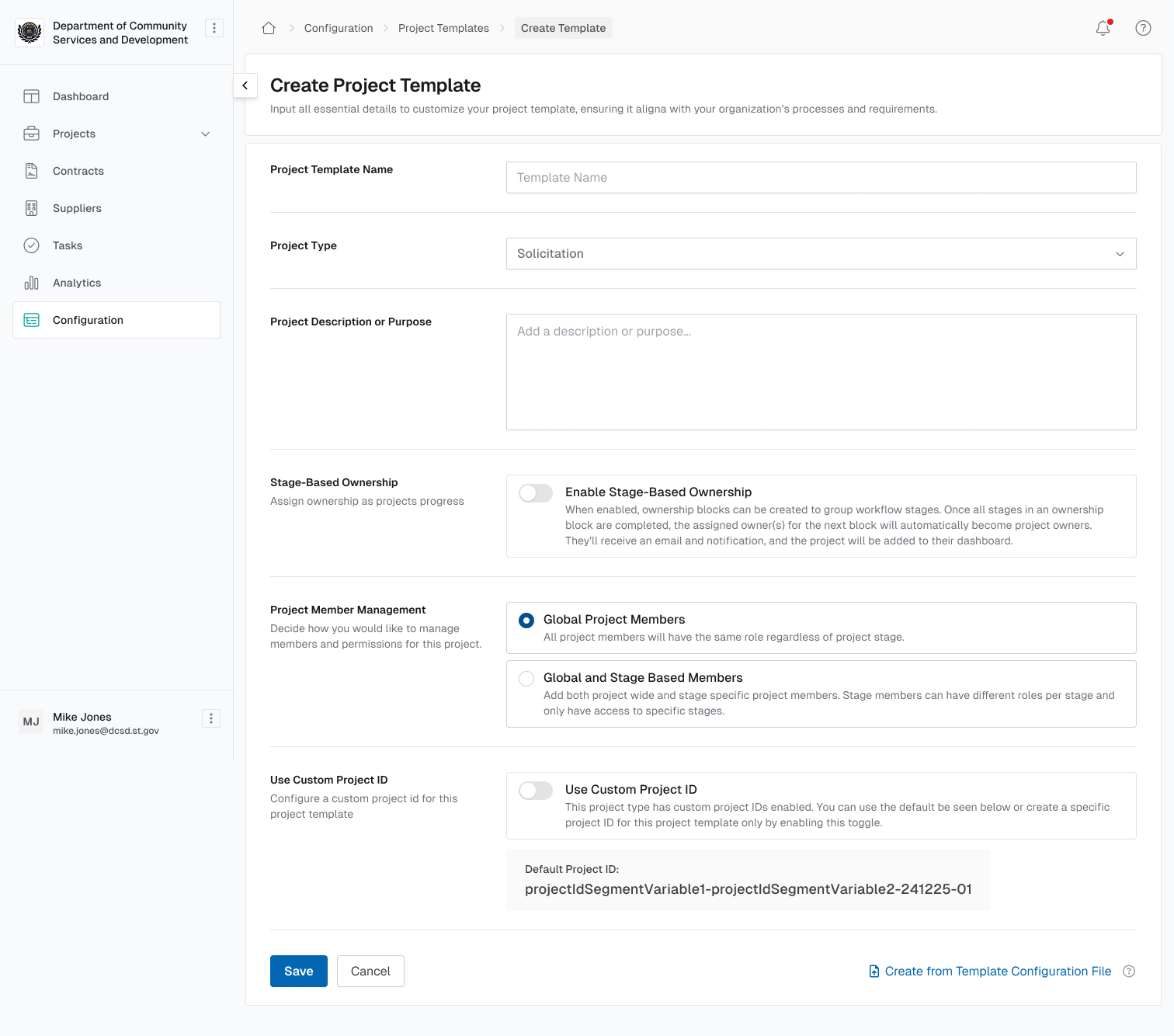
Link to Video Walkthrough
Link to Figma Design
Summary:
This release introduces stage handoff functionality through the use of ownership blocks, allowing grouped stages within a project to be assigned and reassigned across different teams throughout the project lifecycle. This enhances coordination by enabling multi-party management, defining ownership responsibilities, and improving visibility into who owns each part of a project.
New Functionalities Added:
- Enabled multi-party management by introducing ownership blocks in project templates.
- Allowed users to configure ownership blocks and assign specific owners to each block (excluding the first, which defaults to the project creator).
- Supported non-consecutive stages within the same ownership block, including drag-and-drop configuration.
- Added visibility of ownership blocks and assigned owners in both the project template and active workflow.
- Enabled ownership reassignment during a project's lifecycle, updating permissions accordingly.
- Sent email notifications to current and new owners upon reassignment, outlining responsibilities.
- Displayed the project owner clearly on the project card and within the project workflow.
Planned Future Enhancements:
- Add conditional logic to individual stages.
- Add conditional logic to ownership blocks.
- Possibly add logic to conditionally assign owners.
Continue Work on Documents from Previous Stages
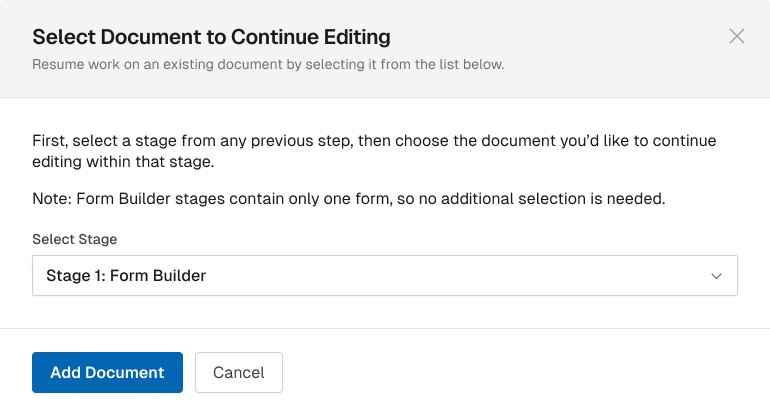
Summary:
This feature enhances collaboration and document continuity across complex workflows by allowing users to continue working on documents created in earlier stages. When a collaborative document is continued, a new timestamped version is created, maintaining a clear version history. For form-based documents, the editing experience remains seamless through a single live instance. This reduces redundancy and streamlines document handling throughout the project lifecycle.
New Functionalities Added:
- Enabled users to add documents from earlier stages (Form Builder and CDM only) when configuring a new Collaborative Document Management (CDM) stage.
- Displayed a UI modal to select both the source stage and the document for continuation.
- Formatted stage names in the dropdown with stage number and either custom or default stage type for better context.
- Created a new editable version when continuing a collaborative document, with timestamp-based version labels to maintain history.
- Allowed collaborative documents to be continued across multiple future stages, each time starting from the most recent version.
- Supported continuation of Form Fill and Form Builder documents without generating new versions, keeping them as a single live instance.
- Displayed only the latest version of continued documents in the Documents tab, avoiding duplication in both project templates and active projects.
API Project Documents and Intake v1
Summary:
This release delivers the first version of a secure, general-purpose API that enables external systems to interact with key components of the Authorium platform. It includes endpoints for authentication, organization and user management, project creation and updates, and document handling. With strict access controls and rate-limiting mechanisms, this foundational API ensures safe, scalable integration with third-party tools and services.
New Functionalities Added:
- Implemented token-based authentication
POST /auth/loginfor secure API access. - Enabled organization-level operations:
- Retrieved organization details
GET /organizations/{id}. - Listed accessible organizations for a user
GET /organizations.
- Retrieved organization details
- Developed user-level endpoints:
- Fetched user profile details
GET /users/{id}. - Listed projects assigned to a user
GET /users/{id}/projects.
- Fetched user profile details
- Built project management endpoints:
- Created new projects
POST /projects. - Updated project info and status
PATCH /projects/{id},PATCH /projects/{id}/status. - Retrieved specific and all projects
GET /projects/{id},GET /projects.
- Created new projects
- Delivered document handling capabilities:
- Created and updated documents
POST /documents,PATCH /documents/{id}. - Retrieved documents by ID or by project
GET /documents/{id},GET /projects/{id}/documents. - Changed document status
PATCH /documents/{id}/statusto reflect workflow progression (e.g., Draft, Approved).
- Created and updated documents
- Enforced strict API security protocols:
- Token revocation and management.
- Authentication required for every request.
- Headers only for API secrets—no query string usage.
- HTTPS-only traffic; HTTP requests are rejected.
- Rate limiting of 100 requests/minute with 429 response and exponential backoff guidance.
- Verified request authorization using role-based access control (e.g., cancancan gem).
Planned Future Enhancements:
- Extend the API to support bi-directional data syncing with ServiceNow.
- Release finalized API documentation for developers.
- Enable Authorium-side enhancements to streamline ServiceNow integrations.
Conga Contract Header Import to Contract Repository (Contract Lifecycle Management)
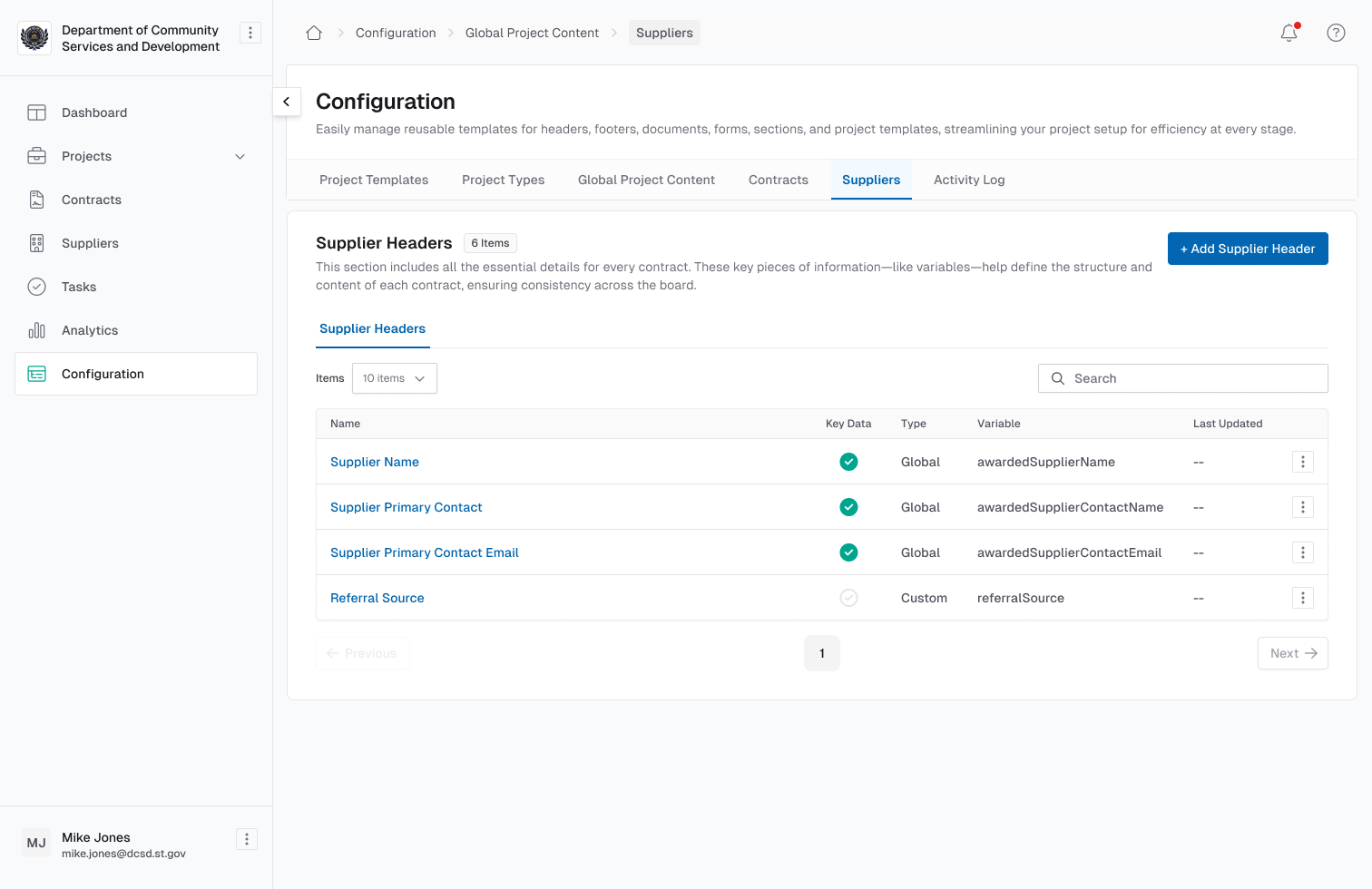
Summary:
This enhancement streamlines contract data management by enabling the manual import of contract headers from Conga (CDSSS) into the Authorium contract repository. Imported contracts retain field order, metadata, supplier relationships, and amendment hierarchies. The feature supports visibility controls for restricted contracts and ensures data completeness—even for inactive suppliers—by linking all relevant details. This provides a structured foundation for managing legacy contracts and simplifies future amendments.
New Functionalities Added:
- Imported contract header data from Conga into the contract repository, including field values, metadata, and defined relationships.
- Displayed contract header data on the contract detail page, maintaining Conga-defined field order and applying non-configurable conditional visibility rules.
- Linked parent and child contracts during import to preserve amendment hierarchies.
- Configured permissions and visibility rules to restrict access to sensitive or restricted contracts.
- Automatically created supplier organizations for each supplier found in the contract data, even if the organization is initially inactive.
- Linked supplier data to the imported contract to ensure traceability and completeness.
- Imported and displayed supplier fields on the supplier detail page, with support for configurable fields.
- Enabled creation of contract amendments from imported contracts, maintaining continuity and ensuring links to the original contract.
- Triggered supplier activation and invitation sending upon amendment creation.
Planned Future Enhancements:
- Enhance custom contract fields with conditionality logic and field grouping.
- Advance supplier field configurations for organization profiles.
Embedded Metabase Reports Configuration and Dashboard Display for Solicitations
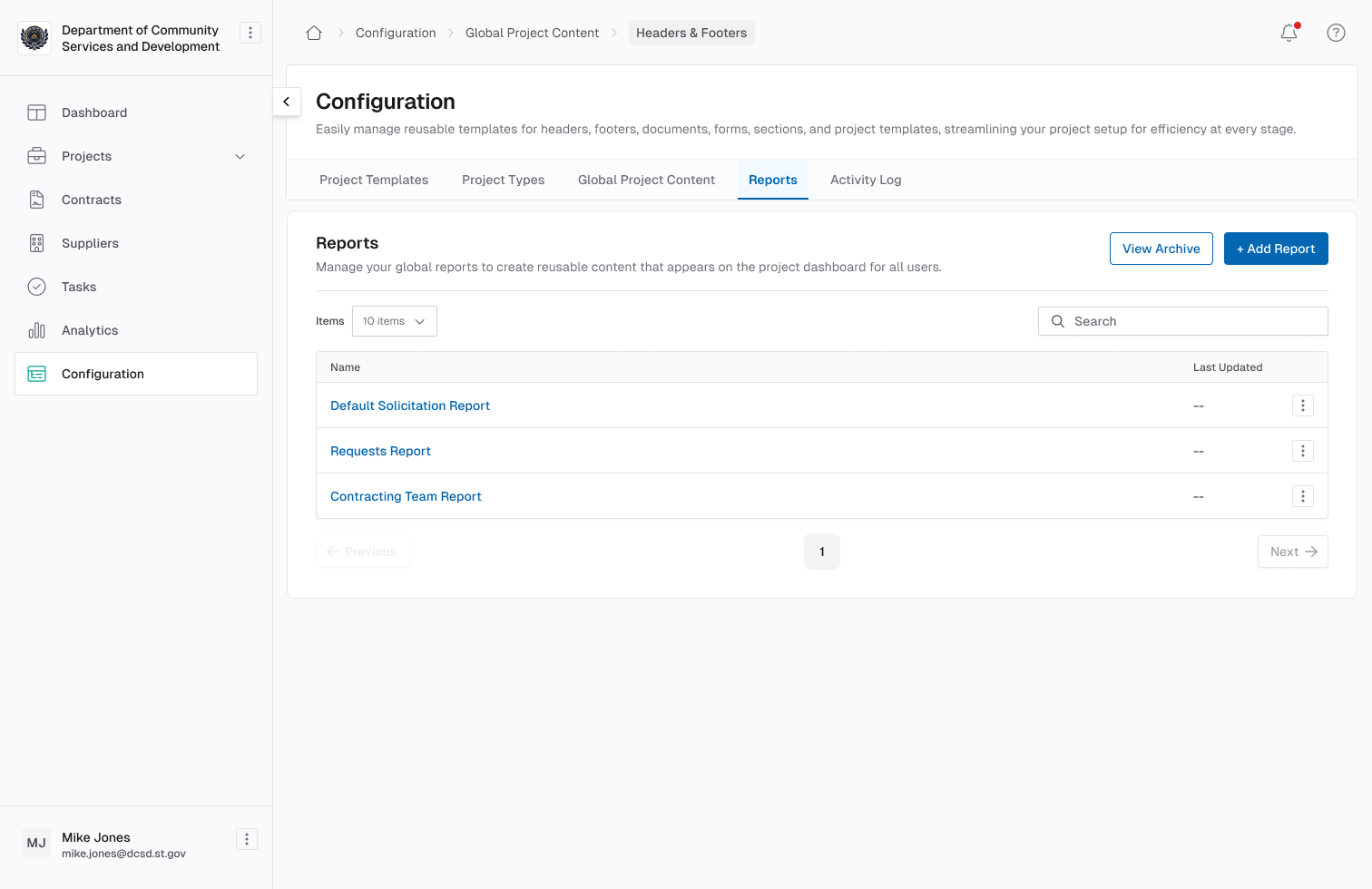
Summary:
This feature introduces a configurable dashboard for embedding external Metabase reports directly within the Authorium app. Admins can define and manage organization-level reports, which are displayed to users via an in-app dropdown menu. Reports are rendered through iframes, allowing users to interact with real-time analytics and visualizations without navigating away from the platform. This centralizes reporting and simplifies access to actionable insights.
New Functionalities Added:
- Added a new "Reports" configuration section where admin users can:
- Create custom report entries with a title, description, and Metabase URL.
- Manage available reports centrally for the organization.
- Integrated a dashboard dropdown menu to:
- Display report options configured by admins.
- Render the selected report's title, description, and embedded iframe within the dashboard view.
- Supported seamless embedding of external Metabase reports using iframes, enabling users to interact with reports without leaving the app.
DocuSign Integration for Contract Execution


Link to Video Walkthrough
Link to Figma Design
Summary:
This feature introduces a seamless integration between Authorium and DocuSign, allowing users to initiate, manage, and complete signature workflows directly from the Authorium platform. Users can select documents created or uploaded within Authorium, send them to DocuSign for execution, and track and store the signed contracts without leaving the platform.
New Functionalities Added:
- Created a new Integrations tab in Settings, where users can manage all third-party service connections.
- Added a DocuSign integration tile to the Integrations tab for configuration and connection.
- Enabled contract selection within the project's contract administration page for DocuSign workflows.
- Introduced the "Sign with DocuSign" action button, allowing users to launch the signature process using their personal DocuSign credentials.
- Allowed users to include both Authorium-generated documents and local files in a DocuSign envelope.
- Implemented real-time contract status notifications to keep users informed within the Authorium project environment.
- Stored signed DocuSign documents directly in the project's record, organized in a table format.
- Displayed integration status warnings, including banners and tooltips, to guide users when an integration is not connected or configured.
Planned Future Enhancements:
- Users will be able to configure the default signature method within Organization Settings.
Online Submissions: Select Suppliers to Invite from Existing Supplier Pools
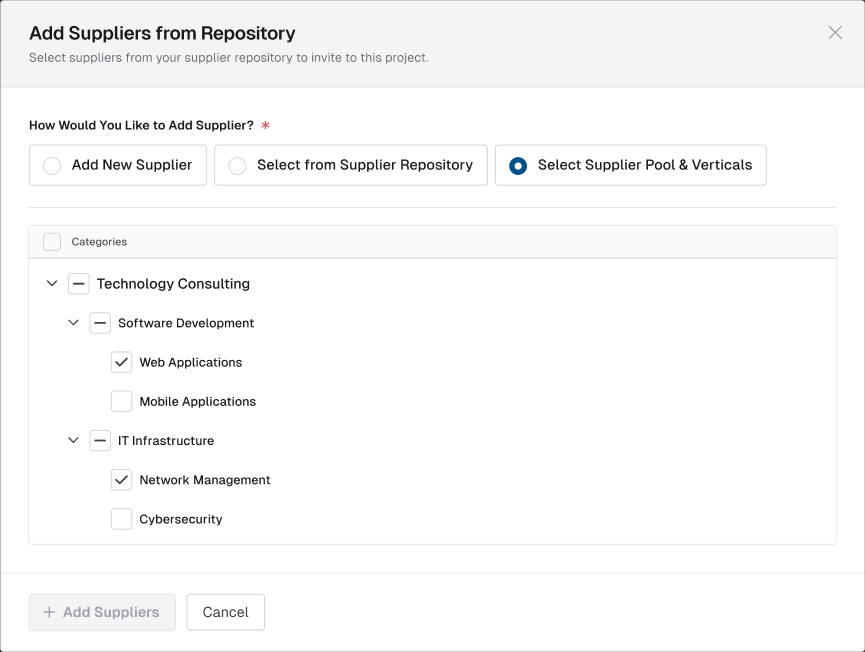
Summary:
This feature enables users to choose whether to add new suppliers or select existing suppliers when inviting them to submit or participate in the PO stage. When selecting existing suppliers, users can choose the pool and vertical associated with the supplier, allowing them to find and invite the correct suppliers easily. Additionally, if supplier organizations are added to a pool but have not yet been activated, users can update or use the primary contact for the supplier and send an invitation to the primary contact once the supplier is invited for submissions or when the PO is generated.
New Funcionalities Added:
- Ability for users to choose between adding new suppliers or selecting existing suppliers for invitations.
- Ability to select a pool and vertical to filter and select suppliers.
- Ability to use or update the primary contact details for suppliers in a pool that has not been activated yet.
- Sending out supplier invitations when suppliers are invited to submit or when the Purchase Order (PO) is generated.
Enable Single Sign-On (SSO) for Two Organizations with the Same Domain
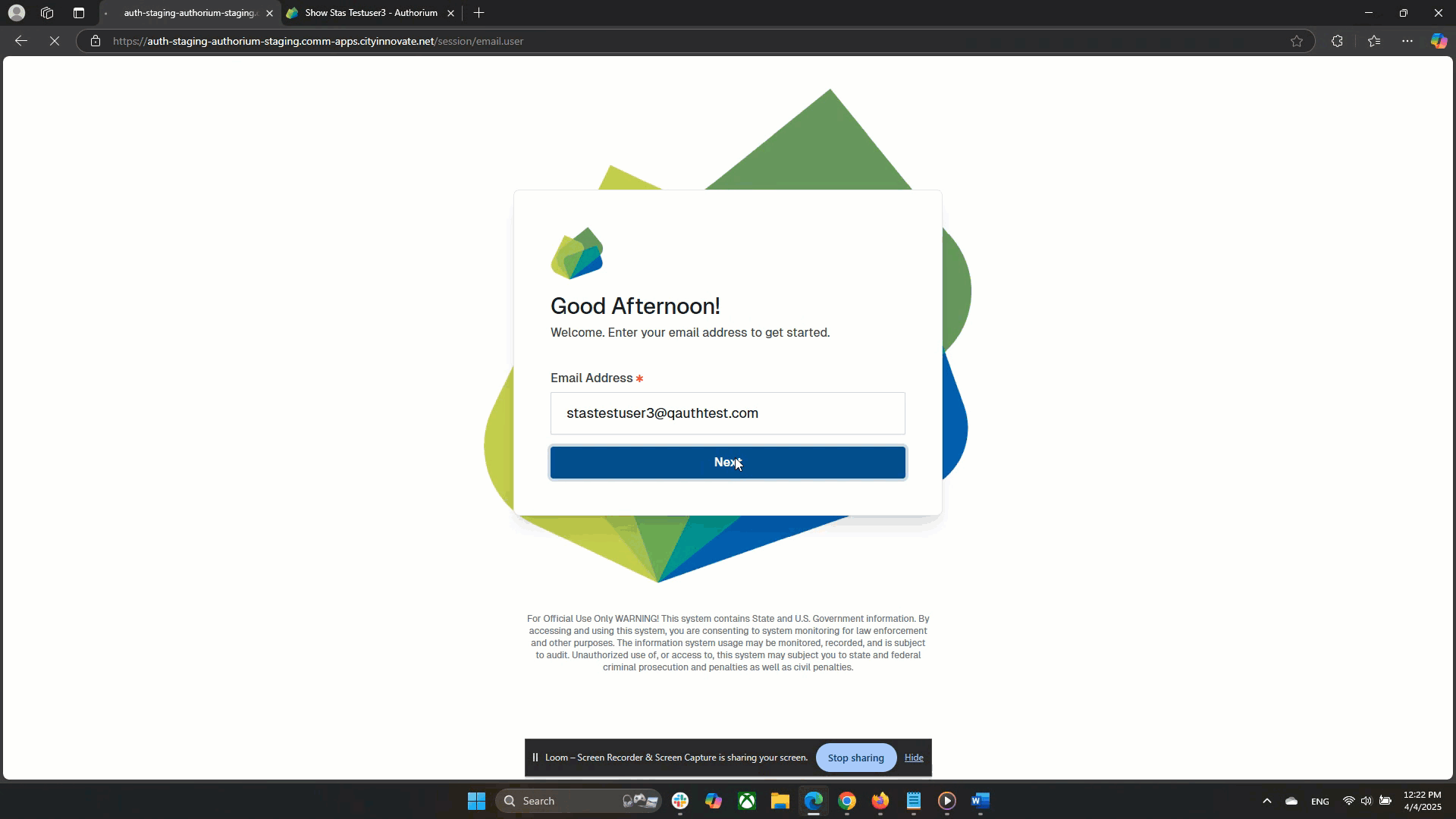
Summary:
This feature enhances support for configuring Single Sign-On (SSO) across multiple organizations using the same domain. It ensures that users from each organization can authenticate via SSO while maintaining strict access boundaries. Users must be explicitly assigned to an organization to access it, preventing unauthorized cross-organization access even when domains overlap.
New Funcionalities Added:
- Support for multi-organization Single Sign-On (SSO) using the same domain, with strict access isolation between organizations.
- Users must be explicitly added to an organization to gain access, even if authenticated through SSO.
Contract Lifecycle Management (CLM): Contract Amendments and Renewals
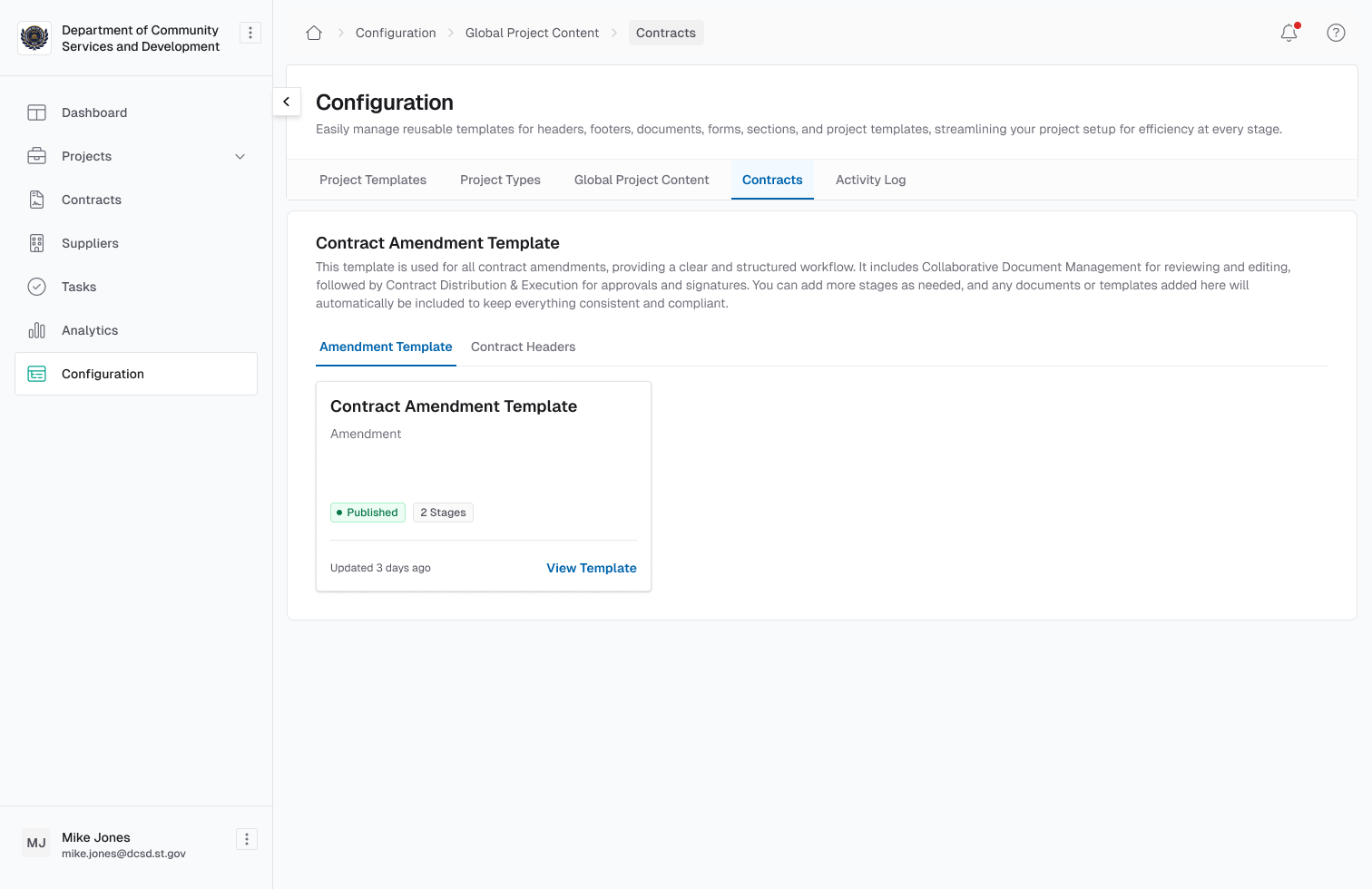
Summary:
This feature introduces the ability to create and manage contract amendments within the contract repository. Amendments are stored in a dedicated tab linked to the original contract and its associated project. Each amendment functions as a new project type with CDM (Collaborative Document Management) and CD&E (Contract Distribution and Execution) stages, enabling full lifecycle management— including document handling, signature workflows, and change tracking—similar to standard contracts.
New Functionalities Added:
- Contract Amendment Creation with the ability to select signature options.
- Configurable Contract and Amendment IDs.
- Document Versioning: A new version of contract documents are created for amendments.
- File Uploads to Amendments.
- Track Changes are enabled for document updates.
- Project Ownership and User Invitations are managed based on the creator.
- Contract Header and Supplier Variables.
Planned Future Enhancements:
- Amendments and Addendums for other stages in the app.
- Integration with AdobeSign
Projects: Add and Remove a Stage to a Project after it has Started
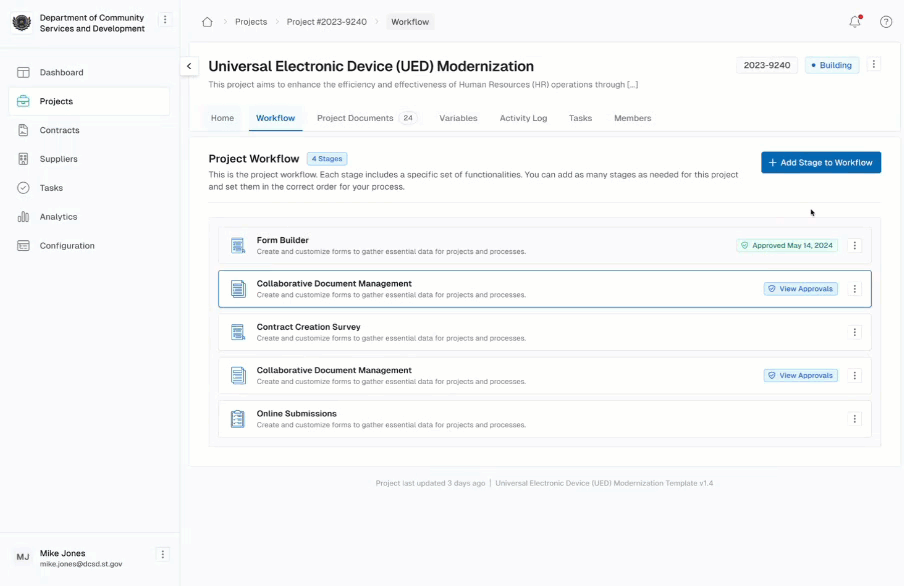
Summary:
This feature allows project or stage owners to add new stages to ongoing projects without restarting them. New stages can be inserted after completed or in-progress stages, maintaining the integrity of the existing workflow. This enhances flexibility in project progression and lifecycle management. Users can configure stage-specific settings, define business rules, assign stage ownership, and add approval steps to each newly added stage.
New Functionalities Added:
- Adding stages to in-progress projects without restarting them.
- Configuring stage-specific requirements based on stage type.
- Assigning ownership, setting up MSA (Multi Step Approval), and attaching documents at the stage level.
- Applying business rules to individual stages.
- Integrating document management and supplier interactions across all stages.
Planned Future Enhancements:
- Adding ownership to stages added to a project in progress.
Multi-Party Project Assignment & Rejection
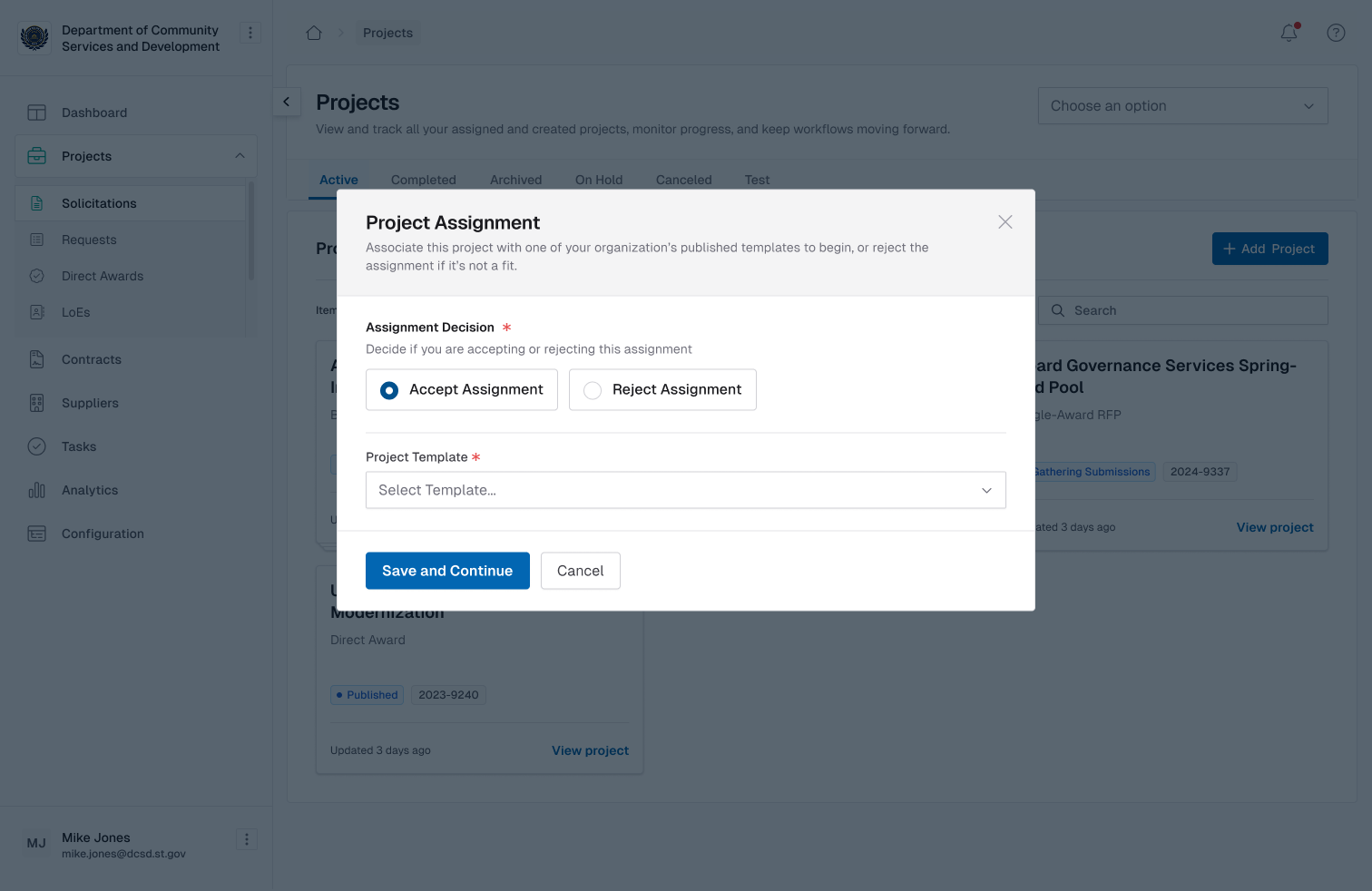
Summary:
This feature improves the Multi-Party Project Assignment workflow by introducing support for assignment rejection. Assigned participants can now reject a project assignment with a required reason. The request is automatically routed back to the assigning party, who can review the feedback and choose to resubmit the request if needed. This enhancement promotes transparency, streamlines communication, and supports a more efficient project assignment process.
New Functionalities Added:
- Rejection option for assigned participants in project assignments.
- Required reason input for all assignment rejections.
- Automatic response and routing of rejected assignments back to the assigning party.
- Option for the assigning party to review and resubmit the same request after rejection.
Authorium Editor Table Improvements
Summary:
This release introduces a series of enhancements and fixes to improve the table editing experience within the Authorium Editor. The updates address formatting consistency, layout control, usability improvements, and stability in simple and nested table structures. These changes aim to provide users with more precise control and a smoother, more reliable editing workflow when working with tables.
New Functionalities Added:
- Improved formatting consistency for tables pasted from external sources.
- Added table alignment buttons to the editor toolbar.
- Enabled automatic distribution of rows and columns.
- Introduced support for row resizing within tables.
- Preserved formatting when inserting new rows and columns.
- Modified table alignment to prevent unwanted text wrapping.
- Enabled resizing of the leftmost column.
- Resolved issues with merging cells in nested tables.
Document Export Bugs Correction and Enhancements
Summary:
This epic enhances the document export experience by resolving key formatting issues, improving hyperlink display, refining Table of Contents (ToC) behavior, and ensuring consistent export quality for form builder documents. The goal is to ensure that the Collaborative Document Management (CDM) tool and form-generated documents maintain a professional appearance while preserving full functionality for PDF exports and signature workflows.
New Functionalities Added:
- Fixed hyperlink formatting to remove the unnecessary "+" symbol from exported documents.
- Improved form builder formatting to enhance the quality of document exports.
- Enabled support for page numbers in document templates for clearer structure and navigation.
- Added guidance for header and footer spacing, including the use of Shift+Enter for manual line breaks.
Planned Future Enhancements:
- Progress is underway on Table of Contents visibility and smart link functionality, with updates planned for upcoming releases.
- Table of Contents (ToC) Export Issue—The ToC cannot be omitted when exporting the first document separately (AA-3195). Options for managing ToC visibility in non-combined exports are under review.
- Smart Links Functionality – Smart links do not work across different documents. A fix is planned for May with the release of merged PDF functionality (AA-3019).
Passing Documents in Multi-Party Project Assignment (MPPA) Stage
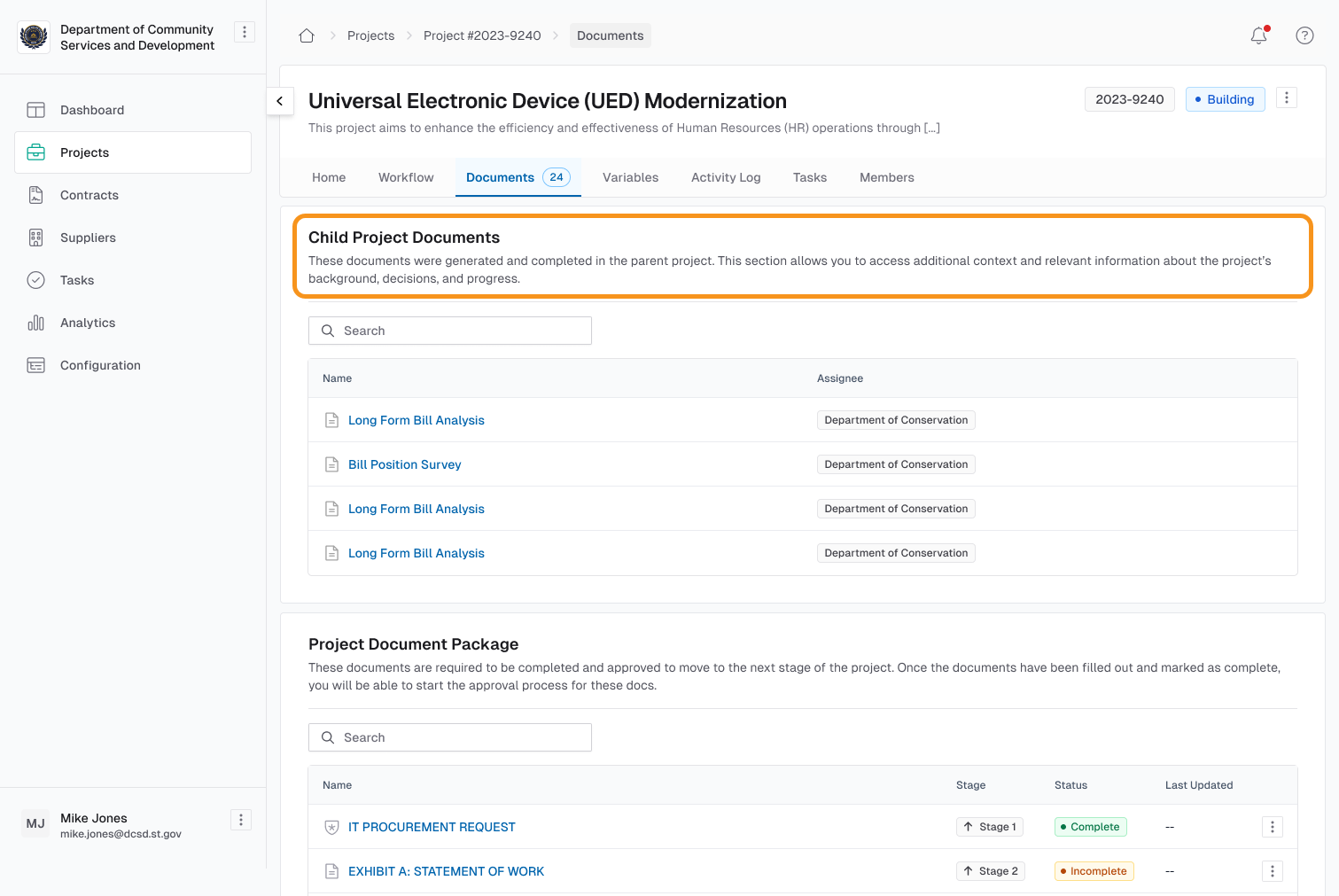
Summary:
This feature introduces document sharing across parent and child projects during the Multi-Party Project Assignment (MPPA) stage. Documents completed in the parent project's Form Builder stage are automatically passed down to all child projects as read-only. In turn, all documents from child projects are shared with the parent and tagged by the child project owner for clarity and traceability. This feature also includes export and reporting capabilities to support easier documentation management.
New Functionalities Added:
- Automatic downstream sharing of Form Builder documents (read-only) from parent-to-child projects.
- Upstream syncing of all child project documents to the parent project.
- Tagging of child documents by originating project owner.
- Read-only access for all shared documents.
- Bulk export options: download as ZIP or combined PDF from the parent project.
Planned Future Enhancements:
- Support for All Document Types: Extend document sharing beyond Form Builder to include all documents between parent and child projects, with read-only access.
- Variable Sharing: Introduce the ability to pass variables between projects. This has been postponed due to a planned restructure of how variables are handled, which is scheduled for May.
- Improved Navigation & Visibility: Potential UI enhancements, such as navigation buttons or tabs, to help users quickly access shared documents and data between parent and child projects, even when project structures differ.